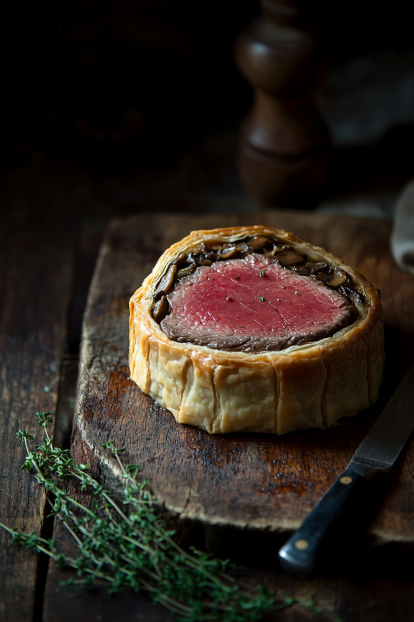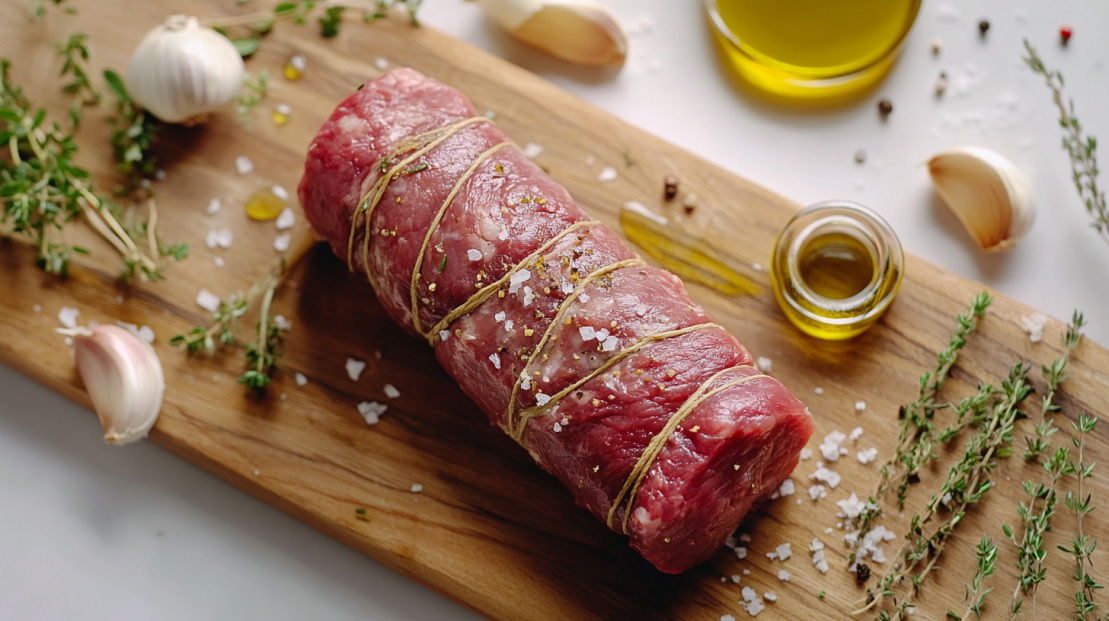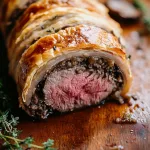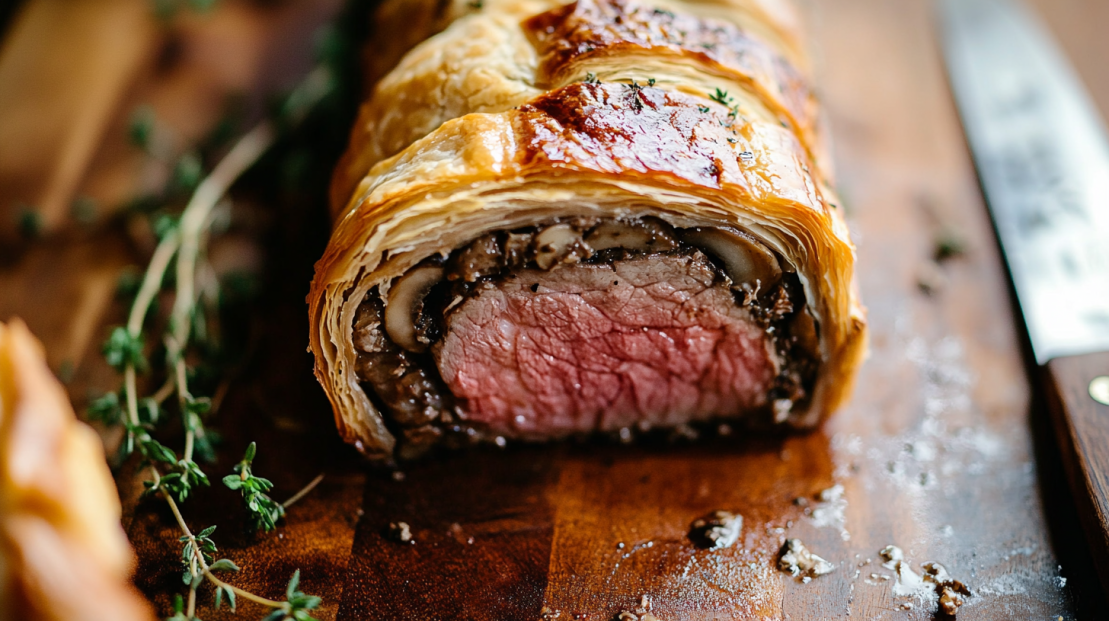Perfect Beef Wellington Recipe Everyone Can Master
Beef Wellington has a reputation. People whisper about it like it’s sacred – all puff pastry and fear of failure. Too fancy for home cooks, too easy to mess up. I used to think the same way until I made it for the first time and realized: it’s not about being perfect, it’s about being careful where it counts.
You don’t need a restaurant brigade to pull this off.
You just need a tenderloin, a little patience, and the confidence to roll with it. The crust might crack, the beef might cook a shade more than you planned – it will still taste incredible. And if you want to give it a little chef’s touch? My duxelles gets a spoonful of truffle oil. It’s not traditional, but it adds that earthy depth that makes people stop mid-bite.

Looking for other impressive mains? Try this juicy bistro steak recipe that’s just as elegant but faster to prepare.
Pro Tips for Making Beef Wellington

A few things I’ve learned after making more of these than I can count:
Always rest before slicing. Ten minutes is the sweet spot.
Cook down the mushrooms until they’re nearly a dry paste. Any leftover moisture will ruin the pastry. Be patient!!!
Chill the beef after wrapping in prosciutto. It holds its shape better.
Use a thermometer, not guesswork. Pull at 125°F for medium-rare, then rest it.
Keep your pastry cold. If it warms up and turns floppy, toss it back in the fridge for a minute.
Score the top. Looks good and lets steam escape.
These roasting techniques will give you extra confidence when baking with puff pastry and beef.
What Cut of Meat Works Best?

Tenderloin is the classic. There’s a reason for that – it’s tender, uniform in shape, and cooks evenly. When I was first taught to make Wellington, the chef explained it like this: “If the beef cooks unevenly, you’ve already lost.” That stuck with me.
You can use other cuts, like striploin or eye of round, but be ready for trickier wrapping and longer cooking. If this is your first time, stick with tenderloin. It’s forgiving.
If you’re curious about other cuts beyond tenderloin, my guide on decoding meat cuts explains which ones shine in different dishes.
Ingredients for the Ultimate Beef Wellington
Every component of this recipe plays a vital role. From the tender beef to the buttery puff pastry, here’s what you’ll need:
For the Beef:
- 2 to 3-pound beef tenderloin (center-cut): This premium cut ensures tenderness and flavor.
- 2 teaspoons salt: Enhances the natural taste of the beef.
- 1 teaspoon black pepper: Adds a subtle kick to the meat.
- 2 tablespoons olive oil: Aids in achieving a golden crust during searing.
- 2 tablespoons Dijon mustard: Brings a tangy layer that cuts through the richness of the dish.
For the Mushroom Duxelles:
- 1 pound mushrooms (button, cremini, or shiitake): Earthy, savory, and essential for the dish’s umami flavor.
- 2 shallots, finely chopped: Sweet, aromatic, and complementary to the mushrooms.
- 2 cloves garlic, minced: Provides depth and a hint of spice.
- 2 tablespoons unsalted butter: Adds richness to the duxelles.
- 1 tablespoon truffle oil (optional): A luxurious addition that sets this recipe apart.
- 1 teaspoon fresh thyme leaves: Herbal notes that balance the flavors.
- 1/2 teaspoon salt and 1/4 teaspoon pepper: For seasoning the duxelles to perfection.
The duxelles layer is essential for keeping your puff pastry crisp while adding rich, earthy flavors. If you’re curious about why mushrooms shine in restaurant-quality dishes, read our article on why restaurant mushrooms taste better.
For the Assembly:
- 8 to 10 thin slices of prosciutto: Wraps the beef and adds a salty, savory contrast.
- 1 pound puff pastry (thawed, if frozen): The crisp, golden shell that makes Beef Wellington iconic.
- 1 egg, lightly beaten: Helps seal the pastry and gives it a beautiful sheen.
- Flour (for dusting): Prevents sticking when rolling out the pastry.
Optional Red Wine Sauce:
- 2 tablespoons unsalted butter: Rich base for the sauce.
- 1 shallot, finely chopped: Adds a mild onion flavor.
- 1/2 cup red wine: Provides acidity and depth.
- 1/2 cup beef stock: Enhances the meaty flavors.
- 1 teaspoon cornstarch mixed with 1 tablespoon water: For thickening the sauce.
Need a reliable way to swap between cups and grams? This grams-to-cups conversion guide will keep measurements accurate.
Step-by-Step Guide to Making Beef Wellington

Step 1: Preparing the Beef
Start by seasoning your beef tenderloin generously with salt and pepper.
Heat olive oil in a large skillet over medium-high heat.
Once hot, sear the beef on all sides, including the ends, for 2-3 minutes per side.
The goal is to create a flavorful crust while keeping the inside raw.
Remove the beef from the skillet and brush it with Dijon mustard while it’s still warm.
Set it aside to cool completely.
Step 2: Making the Mushroom Duxelles
In a food processor, pulse the mushrooms, shallots, and garlic until finely chopped.
Melt butter in the skillet over medium heat, then add the mushroom mixture.
Cook, stirring frequently, until the mushrooms look almost dry. This will take some time to do correctly without burning.
The moisture will first weep out of the mushrooms and pool in the pan. Continue to cook down (reduce) until there is no visible liquid.
The moisture needs to completely evaporate and the mixture needs to form a thick paste (about 8-10 minutes).
Stir in the truffle oil, thyme, salt, and pepper, then let the duxelles cool completely.
Step 3: Assembling the Layers
Lay a large sheet of plastic wrap on your work surface.
Arrange the prosciutto slices in overlapping rows to form a rectangle.
Spread the cooled mushroom duxelles evenly over the prosciutto.
Place the beef tenderloin in the center and use the plastic wrap to roll everything tightly into a log.
Twist the ends of the plastic wrap to secure, then refrigerate for at least 30 minutes to firm up.
Step 4: Wrapping in Puff Pastry
Preheat your oven to 400°F (200°C).
Roll out the puff pastry on a lightly floured surface to a rectangle large enough to wrap the beef.
Remove the beef from the plastic wrap and place it in the center of the pastry.
Brush the edges of the pastry with beaten egg, then fold the pastry over the beef, sealing the edges tightly.
Trim any excess pastry and place the wrapped beef seam-side down on a baking sheet lined with parchment paper.
Brush the pastry with more egg wash and score the top with a sharp knife for decoration.
Step 5: Baking to Perfection
Bake the Wellington in the preheated oven for 25-30 minutes, or until the pastry is golden brown and the internal temperature of the beef reaches 125°F (52°C) for medium-rare.
Remove it from the oven and let it rest for 10 minutes before slicing.
The flaky crust is what makes Beef Wellington so iconic. To ensure yours turns out perfectly, explore our tips on roasting techniques, which also apply to creating an even bake for puff pastry.
Before you sear, check out the sauté cooking method guide for pro tips on getting that perfect crust.
Why This Recipe Works
The truffle oil is my move. Just a drizzle in the duxelles takes the mushrooms from earthy to luxurious. It doesn’t overpower, it just lingers in the background, making people ask why it tastes so good.
Want to know why mushrooms hit differently in restaurants? Here’s the truth about why restaurant mushrooms taste better.
Chef Ryan’s Beef Wellington Recipe
Print
Beef Wellington Recipe By Chef Ryan
- Prep Time: 1 hour
- Cook Time: 30 minutes
- Total Time: 1 hour 30 minutes
- Yield: 6 Servings 1x
- Category: Main Course
- Method: Baking, Searing
- Cuisine: British, American
Description
This Beef Wellington recipe is my modern take on the classic British dish. It features a juicy beef tenderloin wrapped in prosciutto, a flavorful mushroom duxelles, and golden puff pastry. My unique twist includes a hint of truffle oil in the mushroom duxelles, adding a subtle layer of luxurious depth to the dish. Perfect for special occasions, this recipe will impress your guests with its combination of tender beef, crisp pastry, and rich flavors.
Equipment
- Large skillet
- Food processor
- Plastic wrap
- Parchment paper
- Baking sheet
- Meat thermometer
- Pastry brush
Ingredients
For the Beef:
- 2 to 3-pound beef tenderloin (center-cut)
- 2 teaspoons salt
- 1 teaspoon freshly ground black pepper
- 2 tablespoons olive oil
- 2 tablespoons Dijon mustard
For the Mushroom Duxelles:
- 1 pound mushrooms (button, cremini, or shiitake), finely chopped
- 2 shallots, finely chopped
- 2 cloves garlic, minced
- 2 tablespoons unsalted butter
- 1 tablespoon truffle oil (optional)
- 1 teaspoon fresh thyme leaves (optional)
- 1/2 teaspoon salt
- 1/4 teaspoon black pepper
For Assembly:
- 8 to 10 thin slices of prosciutto
- 1 pound puff pastry (thawed, if frozen)
- 1 large egg, lightly beaten (for egg wash)
- Flour (for dusting)
Optional Red Wine Sauce:
- 2 tablespoons unsalted butter
- 1 shallot, finely chopped
- 1/2 cup red wine
- 1/2 cup beef stock
- 1 teaspoon cornstarch mixed with 1 tablespoon water (for thickening)
Instructions
- Prepare the Beef:
- Season the beef tenderloin with salt and pepper.
- Heat olive oil in a large skillet over medium-high heat.
- Sear the beef on all sides for 2-3 minutes per side until browned.
- Remove from skillet and brush with Dijon mustard. Allow to cool.
- Make the Mushroom Duxelles:
- In a food processor, finely chop the mushrooms, shallots, and garlic.
- Melt butter in the same skillet over medium heat.
- Add the mushroom mixture and cook, stirring often, until most of the moisture has evaporated (8-10 minutes).
- Stir in truffle oil, thyme, salt, and pepper. Let cool.
- Assemble the Wellington:
- Lay plastic wrap on a flat surface. Arrange prosciutto slices on top, slightly overlapping to form a rectangle.
- Spread the mushroom duxelles evenly over the prosciutto.
- Place the seared beef in the center. Use the plastic wrap to roll the prosciutto and duxelles around the beef into a tight log. Chill for 30 minutes.
- Wrap in Puff Pastry:
- Preheat oven to 400°F (200°C).
- Roll out puff pastry on a floured surface to a rectangle large enough to cover the beef.
- Remove beef from the plastic wrap and place it in the center of the pastry.
- Brush the edges of the pastry with egg wash. Fold the pastry over the beef, sealing the edges. Trim any excess pastry.
- Place seam-side down on a parchment-lined baking sheet.
- Brush the pastry with more egg wash and score the top with a sharp knife.
- Bake:
- Bake in the preheated oven for 25-30 minutes until golden brown and the internal temperature of the beef reaches 125°F (52°C) for medium-rare.
- Let rest for 10 minutes before slicing.
- Optional Red Wine Sauce:
- In a small saucepan, melt butter and sauté shallots until softened.
- Deglaze with red wine and reduce by half.
- Add beef stock and simmer. Stir in cornstarch mixture to thicken. Strain and serve warm with the Beef Wellington.
Notes
Adding truffle oil to the mushroom duxelles elevates this Beef Wellington recipe with a touch of luxury that complements the earthy mushrooms and buttery puff pastry. This small change makes the recipe stand out without overwhelming the classic flavors.
Nutrition
- Serving Size: 1 Serving
- Calories: 720
- Fat: 45g
- Carbohydrates: 35g
- Protein: 42g
Ingredient Alternatives
Don’t have everything on hand? You can still make it work.
Puff pastry: gluten-free pastry, phyllo, or even shortcrust.
Mushrooms: swap with chestnuts, walnuts, or caramelized onions.
Prosciutto: Parma ham, pancetta, or even turkey bacon will do.
Herb swaps can be tricky – this quick chart on the fresh-to-dried herb ratio makes it simple.
Common Mistakes (and How to Dodge Them)
- Soggy pastry? Mushrooms weren’t cooked long enough or beef wasn’t chilled.
- Overcooked beef? You skipped the thermometer or seared too long.
- Pastry falling apart? Too much overlap or not sealed with egg wash.
Get these three things right and you’re golden.
Precision matters—learn why a scale beats cups every time in this piece on the importance of kitchen scales.
What to Serve with Beef Wellington Recipe
Think balance. The dish is rich – the sides shouldn’t compete.
- Roasted carrots or Brussels sprouts.
- Creamy mashed potatoes or a silky purée.
- Green beans with toasted almonds.
- A simple salad with vinaigrette.
And if you want to really finish it off right, a red wine sauce ties everything together.
For a seasonal side, these citrus roasted Brussels sprouts balance out the richness beautifully.
Beef Wellington FAQs
Yes, you can assemble it up to the pastry wrapping stage and refrigerate it for up to 24 hours. Bake fresh for the best results.
Cook the mushroom duxelles thoroughly until dry, and chill the wrapped beef before adding the pastry.
Parma ham, turkey bacon, or pancetta are great substitutes.
Absolutely! Cut the beef into smaller portions and follow the same process, adjusting baking time accordingly.
Warm slices in a low oven (300°F) to maintain the pastry’s crispness and the beef’s tenderness.
A bold red like Cabernet Sauvignon or a silky Pinot Noir pairs beautifully.
Yes, freeze it before baking. Thaw in the fridge overnight and bake as directed
The Final Bite
This isn’t about chasing perfection. Beef Wellington is about the drama of bringing it to the table, slicing into it, and seeing everyone’s face light up. If you follow the steps and give it the patience it deserves, you’ll get there.
I’ve cooked this in fine dining rooms and for family dinners at home. Both times, it had the same effect – silence at the first bite, then a chorus of “wow.” That’s what food should do.
About the Author
Ryan Yates is a culinary expert with over 20 years of experience in commercial kitchens. As a working executive chef, he has a passion for creating delicious, accessible recipes that bring joy to home cooks everywhere. Ryan believes in the magic of simple ingredients and loves sharing his knowledge to help others find happiness in cooking.


